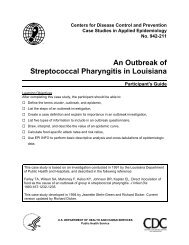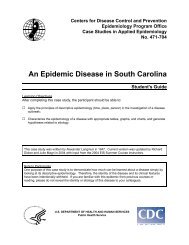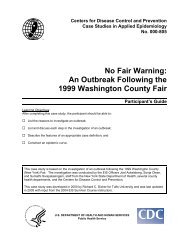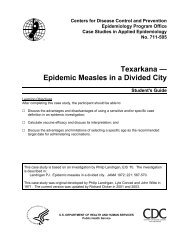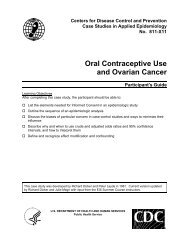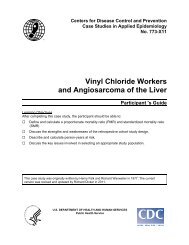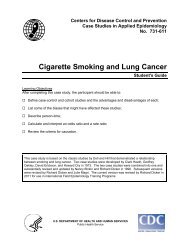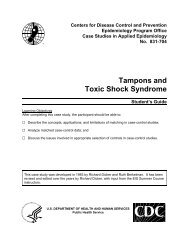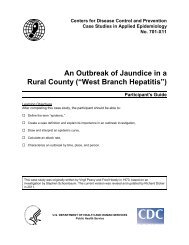A Measles Epidemic in a Highly Vaccinated Population ... - Library
A Measles Epidemic in a Highly Vaccinated Population ... - Library
A Measles Epidemic in a Highly Vaccinated Population ... - Library
Create successful ePaper yourself
Turn your PDF publications into a flip-book with our unique Google optimized e-Paper software.
Centers for Disease Control and Prevention<br />
Case Studies <strong>in</strong> Applied Epidemiology<br />
No. 911–111<br />
A <strong>Measles</strong> <strong>Epidemic</strong><br />
<strong>in</strong> a <strong>Highly</strong> Vacc<strong>in</strong>ated <strong>Population</strong><br />
(“<strong>Measles</strong> <strong>in</strong> Burundi”)<br />
Learn<strong>in</strong>g Objectives<br />
After complet<strong>in</strong>g this case study, the participant should be able to:<br />
Discuss methods for estimat<strong>in</strong>g vacc<strong>in</strong>ation coverage;<br />
s<br />
Student's Guide<br />
Describe the difference between a convenience sample and a probability sample;<br />
Describe the sampl<strong>in</strong>g method used <strong>in</strong> WHO-EPI surveys; and<br />
Calculate and <strong>in</strong>terpret vacc<strong>in</strong>e efficacy.<br />
This case study was developed by Robert Chen and Bernard Morniere <strong>in</strong> 1991. It was adapted for use<br />
<strong>in</strong> the EIS Summer Course by Robert Chen, Bernard Morniere and Richard Dicker. The current version<br />
was revised by Richard Dicker.<br />
U.S. DEPARTMENT OF HEALTH AND HUMAN SERVICES<br />
Public Health Service
CDC-EIS: <strong>Measles</strong> <strong>in</strong> Burundi — Student’s Guide (911-111) Page 2<br />
PART I — Vacc<strong>in</strong>e Coverage<br />
Burundi is a small densely populated nation<br />
located <strong>in</strong> east-central Africa. It is divided <strong>in</strong>to 24<br />
health sectors. Vacc<strong>in</strong>ation aga<strong>in</strong>st measles,<br />
targeted at children 9–23 months of age, was<br />
<strong>in</strong>troduced <strong>in</strong> 1981 <strong>in</strong> Burundi as part of the<br />
World Health Organization's (WHO) Expanded<br />
Programme on Immunization (EPI). Between<br />
1985 and 1988, as part of an <strong>in</strong>itiative to improve<br />
child survival, UNICEF and other donors<br />
<strong>in</strong>vested substantial resources, such as<br />
vacc<strong>in</strong>es, syr<strong>in</strong>ges, refrigerators, transport, and<br />
fuel, <strong>in</strong> the Burundi EPI.<br />
In late 1988, the estimated vacc<strong>in</strong>e coverage <strong>in</strong><br />
Burundi was at its historical high. At the same<br />
time, Health Sector Muy<strong>in</strong>ga, a sector <strong>in</strong><br />
northeast Burundi, reported a dramatic <strong>in</strong>crease<br />
<strong>in</strong> the number of measles cases diagnosed<br />
(Figure 2). This <strong>in</strong>crease surprised the EPI<br />
central staff, s<strong>in</strong>ce the EPI program <strong>in</strong> Health<br />
Sector Muy<strong>in</strong>ga was highly regarded.
CDC-EIS: <strong>Measles</strong> <strong>in</strong> Burundi — Student’s Guide (911-111) Page 3<br />
Question 1: In general, what factors can account for a sudden <strong>in</strong>crease <strong>in</strong> the number of reported<br />
cases of a disease? Which of these factors are plausible <strong>in</strong> this sett<strong>in</strong>g?
CDC-EIS: <strong>Measles</strong> <strong>in</strong> Burundi — Student’s Guide (911-111) Page 4<br />
The <strong>in</strong>crease <strong>in</strong> reported cases evidently<br />
reflected a true epidemic of measles. In light of<br />
this epidemic, some officials began to question<br />
whether the vast resources spent on EPI had<br />
been a wise expenditure.<br />
Question 2: What are possible explanations (hypotheses) for this epidemic? What <strong>in</strong>formation might<br />
you like to have to explore these hypotheses?<br />
The first task taken on by the central EPI staff was to estimate measles vacc<strong>in</strong>e coverage <strong>in</strong> Burundi at<br />
large and <strong>in</strong> Muy<strong>in</strong>ga specifically.<br />
Question 3: How might you estimate measles vacc<strong>in</strong>e coverage?
CDC-EIS: <strong>Measles</strong> <strong>in</strong> Burundi — Student’s Guide (911-111) Page 5<br />
One method for estimat<strong>in</strong>g vacc<strong>in</strong>e coverage is<br />
the so-called "Adm<strong>in</strong>istrative Method." This<br />
method relies on data that should be readily<br />
available to program managers. Basically,<br />
coverage is calculated as a proportion <strong>in</strong> which<br />
the numerator is the number of doses of vacc<strong>in</strong>e<br />
adm<strong>in</strong>istered to the target population, and the<br />
denom<strong>in</strong>ator is the estimated size of the target<br />
population. The measles vacc<strong>in</strong>ation coverage<br />
of children 12–23 months of age can be<br />
calculated as the number of doses received by<br />
children 12–23 months old, divided by the<br />
number of children 12–23 months old. The<br />
number of children 12–23 months old is<br />
estimated by the number of "surviv<strong>in</strong>g <strong>in</strong>fants,"<br />
which is the number of children born alive the<br />
previous year, m<strong>in</strong>us the number of <strong>in</strong>fants who<br />
died before the age of 1 year:<br />
Surviv<strong>in</strong>g Infants (SI) = Live Births (LB) – Infant Deaths (ID)<br />
Question 4: Us<strong>in</strong>g the data <strong>in</strong> Tables 1 and 2, calculate the number of surviv<strong>in</strong>g <strong>in</strong>fants born <strong>in</strong> 1987 <strong>in</strong><br />
Burundi, and <strong>in</strong> 1983 and 1987 <strong>in</strong> Health Sector Muy<strong>in</strong>ga (1983 and 1985 figures for<br />
Burundi are given as examples). Assume a crude birth rate of 4.8% and an <strong>in</strong>fant<br />
mortality rate of 10.5%.<br />
Table 1. Estimated number of surviv<strong>in</strong>g <strong>in</strong>fants <strong>in</strong> Burundi, 1983, 1985, and 1987.<br />
Live births Infant deaths Surviv<strong>in</strong>g <strong>in</strong>fants<br />
Year <strong>Population</strong> (pop x 4.8%) (LB x 10.5%) (LB – ID)<br />
1983 4,400,000 211,200 22,176 189,024<br />
1985 4,700,000 225,600 23,688 201,912<br />
1987 4,900,000 ______ ______ ______<br />
Table 2. Estimated number of surviv<strong>in</strong>g <strong>in</strong>fants <strong>in</strong> Health Sector Muy<strong>in</strong>ga, 1983 and 1987.<br />
Live births Infant deaths Surviv<strong>in</strong>g <strong>in</strong>fants<br />
Year <strong>Population</strong> (pop x 4.8%) (LB x 10.5%) (LB – ID)<br />
1983 287,000 ______ ______ ______<br />
1987 322,000 ______ ______ ______
CDC-EIS: <strong>Measles</strong> <strong>in</strong> Burundi — Student’s Guide (911-111) Page 6<br />
All health centers submit a Monthly Vacc<strong>in</strong>ation<br />
Report on doses of vacc<strong>in</strong>es adm<strong>in</strong>istered to<br />
each of two age groups: 0–11 months and 12–23<br />
months. The target age for measles vacc<strong>in</strong>ation<br />
<strong>in</strong> the Burundi EPI is 9–23 months, and all doses<br />
of measles vacc<strong>in</strong>e adm<strong>in</strong>istered to children 0–<br />
11 months on the Monthly Vacc<strong>in</strong>ation Report<br />
are assumed to have been given at 9–11<br />
months. Strictly speak<strong>in</strong>g, the number of doses<br />
received by children before the age of 24 months<br />
is the sum of the number of doses adm<strong>in</strong>istered<br />
to children ages 12–23 months dur<strong>in</strong>g year (Y)<br />
plus the number of doses adm<strong>in</strong>istered to<br />
children ages 9–11 months dur<strong>in</strong>g year (Y−1).<br />
Thus, the estimated coverage for children who<br />
reached age 24 months dur<strong>in</strong>g year Y can be<br />
calculated as follows:<br />
ESTIMATED COVERAGE =<br />
[Doses 12–23 mo. year (Y)] + [Doses 9–11 mo. year (Y−1)]<br />
Surviv<strong>in</strong>g Infants Born <strong>in</strong> year (Y−1)<br />
Question 5: Us<strong>in</strong>g the data <strong>in</strong> Tables 3 and 4, estimate the measles vacc<strong>in</strong>ation coverage <strong>in</strong> Burundi<br />
<strong>in</strong> 1988, and <strong>in</strong> Health Sector Muy<strong>in</strong>ga <strong>in</strong> 1984 and 1988.<br />
Table 3. Estimated measles vacc<strong>in</strong>ation coverage us<strong>in</strong>g adm<strong>in</strong>istrative method, Burundi, 1984, 1986, 1988<br />
Doses adm<strong>in</strong>istered<br />
Surviv<strong>in</strong>g <strong>in</strong>fants<br />
Year 12–23 mo (Y) + 9–11 mo (Y−1) born year (Y−1) Coverage<br />
1984 90,020 189,024 48%<br />
1986 110,436 201,912 55%<br />
1988 138,140 210,504 ______<br />
Table 4. Estimated measles vacc<strong>in</strong>ation coverage us<strong>in</strong>g adm<strong>in</strong>istrative method, Muy<strong>in</strong>ga, 1984 & 1988.<br />
Doses adm<strong>in</strong>istered<br />
Surviv<strong>in</strong>g <strong>in</strong>fants<br />
Year 12–23 mo (Y) + 9–11 mo (Y−1) born year (Y−1) Coverage<br />
1984 5,430 12,330 ______<br />
1988 9,450 13,833 ______
CDC-EIS: <strong>Measles</strong> <strong>in</strong> Burundi — Student’s Guide (911-111) Page 7<br />
Figure 3 shows the measles vacc<strong>in</strong>ation<br />
coverage estimated by the "Adm<strong>in</strong>istrative<br />
Method" for Muy<strong>in</strong>ga and Burundi for 1980–<br />
1988. Note that Muy<strong>in</strong>ga <strong>in</strong>troduced measles<br />
vacc<strong>in</strong>ation by a mass campaign <strong>in</strong> 1981,<br />
target<strong>in</strong>g children 9–23 months of age, which<br />
resulted <strong>in</strong> a peak <strong>in</strong> coverage <strong>in</strong> 2-year-olds <strong>in</strong><br />
1982. S<strong>in</strong>ce 1981, coverage <strong>in</strong> Muy<strong>in</strong>ga has<br />
generally exceeded the national average. Note<br />
also that coverage levels have improved by at<br />
least 20% s<strong>in</strong>ce "acceleration" of EPI <strong>in</strong> 1986.<br />
Question 6: What are the advantages and disadvantages of the "Adm<strong>in</strong>istrative Method"?<br />
A second way of estimat<strong>in</strong>g vacc<strong>in</strong>e coverage is<br />
by conduct<strong>in</strong>g a field survey, and determ<strong>in</strong><strong>in</strong>g<br />
vacc<strong>in</strong>ation status for a sample of children. In<br />
1984, vacc<strong>in</strong>e coverage was estimated to be<br />
73% <strong>in</strong> Muy<strong>in</strong>ga based on a convenience<br />
sample.
CDC-EIS: <strong>Measles</strong> <strong>in</strong> Burundi — Student’s Guide (911-111) Page 8<br />
Question 7: What is a convenience sample? What other types of sampl<strong>in</strong>g strategy might you<br />
propose for a vacc<strong>in</strong>e coverage survey <strong>in</strong> this sett<strong>in</strong>g?<br />
The method preferred by EPI is the WHO-EPI 2-<br />
step, 30-cluster survey technique. The firststage<br />
sampl<strong>in</strong>g <strong>in</strong>volves the selection of 30<br />
villages or quarters, each village hav<strong>in</strong>g a<br />
probability of be<strong>in</strong>g selected proportionate to its<br />
size. The second stage is the random selection,<br />
<strong>in</strong> each selected village, of the first household to<br />
be visited. As many consecutive households as<br />
necessary are visited until seven children 12–23<br />
months of age are found. The sample size of 30<br />
x 7 children provides an estimate with<strong>in</strong> 10% of<br />
the true coverage.<br />
Table 5 represents selected results from the<br />
coverage surveys done <strong>in</strong> Muy<strong>in</strong>ga <strong>in</strong> 1984 and<br />
<strong>in</strong> Burundi <strong>in</strong> 1986, with comparable estimates<br />
based on the adm<strong>in</strong>istrative method.<br />
Table 5. <strong>Measles</strong> vacc<strong>in</strong>ation coverage, 12- to 23-month-olds.<br />
Location Year Coverage survey Adm<strong>in</strong>istrative method<br />
Muy<strong>in</strong>ga 1984 73% (Convenience Sample) 44%<br />
Burundi 1986 57% (WHO-EPI 30 Cluster) 55%<br />
Question 8: Compare the coverage results obta<strong>in</strong>ed by the "Adm<strong>in</strong>istrative Method" (from Tables 3–4)<br />
with the results from the coverage surveys.<br />
In addition to estimat<strong>in</strong>g coverage, the<br />
<strong>in</strong>vestigators were <strong>in</strong>terested <strong>in</strong> the descriptive<br />
epidemiology of measles occurrence <strong>in</strong> Muy<strong>in</strong>ga<br />
specifically, and <strong>in</strong> Burundi generally.<br />
Question 9: What sources of <strong>in</strong>formation might be used to describe measles occurrence <strong>in</strong> Muy<strong>in</strong>ga<br />
and Burundi?
CDC-EIS: <strong>Measles</strong> <strong>in</strong> Burundi — Student’s Guide (911-111) Page 9<br />
PART II — Surveillance<br />
The Burundi Monthly Epidemiologic Bullet<strong>in</strong><br />
Report was <strong>in</strong>itiated <strong>in</strong> 1980. An estimated 90%<br />
of all health facilities submit a monthly report of<br />
case counts and deaths for measles and 27<br />
other illnesses. Figures 4 and 5 summarize the<br />
1980–1988 measles <strong>in</strong>cidence and mortality data<br />
available to the EPI office, as well as the<br />
chickenpox <strong>in</strong>cidence reported via the same<br />
surveillance system.
CDC-EIS: <strong>Measles</strong> <strong>in</strong> Burundi — Student’s Guide (911-111) Page 10<br />
A recently completed study based on the<br />
registries of the eight major prov<strong>in</strong>cial hospitals<br />
provided additional data on persons admitted to<br />
hospitals for measles and deaths from measles,<br />
summarized <strong>in</strong> Figure 6.<br />
Question 10:<br />
Describe and <strong>in</strong>terpret the trends <strong>in</strong> measles morbidity and mortality <strong>in</strong> Burundi.
CDC-EIS: <strong>Measles</strong> <strong>in</strong> Burundi — Student’s Guide (911-111) Page 11<br />
The reproductive capacity of an <strong>in</strong>fectious<br />
pathogen is often summarized as its basic<br />
reproductive number, abbreviated as R 0 . R 0<br />
represents an idealized expected number of<br />
<strong>in</strong>fectious secondary cases generated when a<br />
s<strong>in</strong>gle <strong>in</strong>fectious <strong>in</strong>dividual enters an entirely<br />
susceptible population. <strong>Measles</strong> is one of the<br />
most transmissible <strong>in</strong>fectious agents known, with<br />
estimates of R 0 for measles rang<strong>in</strong>g between 5<br />
and 18, depend<strong>in</strong>g on the location and time at<br />
which these estimates were made. The effective<br />
reproductive number (R) represents the actual<br />
expected number of secondary cases produced<br />
by one <strong>in</strong>fectious <strong>in</strong>dividual <strong>in</strong> a population <strong>in</strong><br />
which many people may be immune because of<br />
prior <strong>in</strong>fection or vacc<strong>in</strong>ation. R usually changes<br />
dur<strong>in</strong>g the course of an epidemic because more<br />
and more people become <strong>in</strong>fected and ga<strong>in</strong><br />
immunity.<br />
To prevent epidemic spread <strong>in</strong> a population, R<br />
must be ma<strong>in</strong>ta<strong>in</strong>ed below 1.0. That means that,<br />
to prevent cont<strong>in</strong>ued transmission, each<br />
<strong>in</strong>fectious case must produce, on average, less<br />
than one additional case. The follow<strong>in</strong>g formulas<br />
allow public health officials to estimate the<br />
percentage of a population that must be<br />
successfully vacc<strong>in</strong>ated to prevent epidemics of<br />
disease:<br />
R = R 0 x proportion of population that is susceptible<br />
Question 11:<br />
Us<strong>in</strong>g the formula provided above and a value of R 0 = 15 for measles, calculate the<br />
proportion of the population that must be successfully vacc<strong>in</strong>ated (or immune from<br />
naturally acquired measles) to prevent an epidemic.
CDC-EIS: <strong>Measles</strong> <strong>in</strong> Burundi — Student’s Guide (911-111) Page 12<br />
If you look closely at Figure 4, you will note<br />
peaks <strong>in</strong> the <strong>in</strong>cidence of measles every couple<br />
of years. Figure 7 below represents an idealized<br />
epidemic cycle of measles <strong>in</strong> a rural region<br />
before and after the <strong>in</strong>troduction of measles<br />
vacc<strong>in</strong>ation.<br />
Question 12:<br />
Why do certa<strong>in</strong> communicable diseases such as measles have regular epidemic<br />
cycles?
CDC-EIS: <strong>Measles</strong> <strong>in</strong> Burundi — Student’s Guide (911-111) Page 13<br />
PART III — Vacc<strong>in</strong>e Efficacy<br />
Dur<strong>in</strong>g the 1988 outbreak, both parents and<br />
health-care workers noted that many of the<br />
measles cases occurred among children who<br />
had documentation of measles vacc<strong>in</strong>ation.<br />
This suspicion was confirmed when the<br />
surveillance data on vacc<strong>in</strong>ation status of<br />
persons with measles from Muy<strong>in</strong>ga (available<br />
s<strong>in</strong>ce 1985) were reviewed.<br />
Table 7. Vacc<strong>in</strong>ation status of measles cases, Muy<strong>in</strong>ga, 1984–1988.<br />
Number of Proportion of Vacc<strong>in</strong>e coverage<br />
Year measles cases cases vacc<strong>in</strong>ated <strong>in</strong> population<br />
1984 338 N/A 45%<br />
1985 468 7% 48%<br />
1986 1,791 14% 71%<br />
1987 1,084 30% 76%<br />
1988 4,867 28% 70%<br />
Question 13:<br />
Can you conclude from these data that there is a problem with vacc<strong>in</strong>e efficacy?
CDC-EIS: <strong>Measles</strong> <strong>in</strong> Burundi — Student’s Guide (911-111) Page 14<br />
Table 8. Hypothetical populations with vacc<strong>in</strong>e coverage of 0%, 20%, 60%, and 100%.<br />
<strong>Population</strong><br />
A B C D<br />
a. Number of persons <strong>in</strong> population 100 100 100 100<br />
b. Vacc<strong>in</strong>e efficacy (VE) 90% 90% 90% 90%<br />
c. Percent population vacc<strong>in</strong>ated (PPV) 0% 20% 60% 100%<br />
d. Number vacc<strong>in</strong>ated (a × c) _____ 20 _____ _____<br />
e. Number unvacc<strong>in</strong>ated (a − d) _____ 80 _____ _____<br />
f. Number protected (d × b) _____ 18 _____ _____<br />
g. Number vacc<strong>in</strong>ated but susceptible, ill (d − f) _____ 2 _____ _____<br />
h. Total number ill (e + g) _____ 82 _____ _____<br />
i. Percent cases vacc<strong>in</strong>ated (PCV) (g / h) _____ 2.4% _____ _____<br />
Consider the use of a vacc<strong>in</strong>e with 90% efficacy<br />
<strong>in</strong> four different hypothetical populations of 100<br />
people each, with vacc<strong>in</strong>e coverage of 0%,<br />
20%, 60%, and 100%, respectively. Assume<br />
that every unvacc<strong>in</strong>ated person will be exposed<br />
to, and will develop, measles.<br />
Question 14: Complete Table 8.<br />
Question 15:<br />
Based on your response to Question 14, what do you conclude about the relationship<br />
between coverage and number of cases vacc<strong>in</strong>ated?
CDC-EIS: <strong>Measles</strong> <strong>in</strong> Burundi — Student’s Guide (911-111) Page 15<br />
The ability of a vacc<strong>in</strong>e to prevent disease<br />
depends on its potency and proper<br />
adm<strong>in</strong>istration to an <strong>in</strong>dividual capable of<br />
respond<strong>in</strong>g. The success of vacc<strong>in</strong>ation<br />
performed under field conditions may be<br />
assessed by measur<strong>in</strong>g protection aga<strong>in</strong>st<br />
cl<strong>in</strong>ical disease. Such field assessments can be<br />
very useful, particularly when doubt is cast on<br />
the efficacy of the vacc<strong>in</strong>e because of the<br />
occurrence of disease among vacc<strong>in</strong>ated<br />
persons.<br />
Vacc<strong>in</strong>e efficacy is measured by calculat<strong>in</strong>g the<br />
<strong>in</strong>cidence (attack rate) of disease among<br />
vacc<strong>in</strong>ated and unvacc<strong>in</strong>ated persons and<br />
determ<strong>in</strong><strong>in</strong>g the percentage reduction <strong>in</strong><br />
<strong>in</strong>cidence of disease among vacc<strong>in</strong>ated persons<br />
relative to unvacc<strong>in</strong>ated persons. The greater<br />
the percentage reduction of illness <strong>in</strong> the<br />
vacc<strong>in</strong>ated group, the greater the vacc<strong>in</strong>e<br />
efficacy. The basic formula is written as:<br />
VE = (ARU − ARV) / ARU = 1 − (ARV / ARU) = 1 − RR<br />
Where VE = vacc<strong>in</strong>e efficacy;<br />
ARU = attack rate for unvacc<strong>in</strong>ated;<br />
ARV = attack rate for vacc<strong>in</strong>ated; and<br />
RR = risk ratio = ARU / ARV<br />
To exam<strong>in</strong>e vacc<strong>in</strong>e efficacy, <strong>in</strong> January 1989<br />
<strong>in</strong>vestigators conducted a door-to-door census of<br />
all households with children 0–5 years old <strong>in</strong> the<br />
five districts <strong>in</strong> Muy<strong>in</strong>ga hardest hit by the<br />
epidemic. Tra<strong>in</strong>ed <strong>in</strong>terviewers recorded the<br />
date of birth, date of measles vacc<strong>in</strong>ation,<br />
measles disease status (accord<strong>in</strong>g to mother's<br />
assessment), and survival for each child.<br />
<strong>Measles</strong> vacc<strong>in</strong>ation was accepted only if<br />
documented by a vacc<strong>in</strong>ation card. A separate<br />
questionnaire on symptoms was completed for<br />
each person with measles. The results of this<br />
census are shown below (Tables 9a–9d):<br />
Table 9a. <strong>Measles</strong> cases by vacc<strong>in</strong>ation status, Muy<strong>in</strong>ga survey, January 1989 — All children <strong>in</strong> census<br />
(measles cases as reported by mother; children without vacc<strong>in</strong>ation card counted as unvacc<strong>in</strong>ated)<br />
Vacc<strong>in</strong>ation Status <strong>Measles</strong> No measles Total Attack rate<br />
Vacc<strong>in</strong>ated 109 843 952 ARV = 109 / 952 = 11.4%<br />
Unvacc<strong>in</strong>ated 182 607 789 ARU = 182 / 789 = 23.1%<br />
Total 291 1,450 1,741<br />
RR = (109 / 952) / (182 / 789) = 0.1145 / 0.2307 = 0.4963<br />
VE = ([182/789] − [109/952]) / [182/789] = 50.4%<br />
VE = 1 – 0.4963 = 0.5037 = 0.504 = 50.4%<br />
Question 16:<br />
Us<strong>in</strong>g the data <strong>in</strong> Tables 9b-9d, calculate the ARV, ARU, and vacc<strong>in</strong>e efficacy for each<br />
table. Why does each table give different results?
CDC-EIS: <strong>Measles</strong> <strong>in</strong> Burundi — Student’s Guide (911-111) Page 16<br />
Table 9b. <strong>Measles</strong> cases by vacc<strong>in</strong>ation status, Muy<strong>in</strong>ga survey, January 1989 — Unvacc<strong>in</strong>ated children<br />
restricted to those with vacc<strong>in</strong>ation cards (on which there is no record of measles vacc<strong>in</strong>ation).<br />
Vacc<strong>in</strong>ation Status <strong>Measles</strong> No measles Total Calculations<br />
Vacc<strong>in</strong>ated 109 843 952 ARV = ________<br />
Unvacc<strong>in</strong>ated 121 309 430 ARU = ________<br />
Total 230 1,152 1,382 RR = ________<br />
VE =<br />
________<br />
Table 9c. <strong>Measles</strong> cases by vacc<strong>in</strong>ation status, Muy<strong>in</strong>ga survey, January 1989 — Criteria <strong>in</strong> 9B and<br />
measles cases restricted to those with symptoms meet<strong>in</strong>g the case def<strong>in</strong>ition of fever, rash and cough, or<br />
runny nose or red eyes.<br />
Vacc<strong>in</strong>ation Status <strong>Measles</strong> No measles Total Calculations<br />
Vacc<strong>in</strong>ated 49 843 892 ARV = ________<br />
Unvacc<strong>in</strong>ated 59 309 368 ARU = ________<br />
Total 108 1,152 1,260 RR = ________<br />
VE =<br />
________<br />
Table 9d. <strong>Measles</strong> cases by vacc<strong>in</strong>ation status, Muy<strong>in</strong>ga survey, January 1989 — Same criteria <strong>in</strong> Tables<br />
9b and 9c and analysis restricted to children ≥ 9 months of age.<br />
Vacc<strong>in</strong>ation Status <strong>Measles</strong> No measles Total Calculations<br />
Vacc<strong>in</strong>ated 48 840 888 ARV = ________<br />
Unvacc<strong>in</strong>ated 44 116 160 ARU = ________<br />
Total 92 956 1,048 RR = ________<br />
VE =<br />
________<br />
Question 17:<br />
Def<strong>in</strong>e vacc<strong>in</strong>e efficacy <strong>in</strong> common English.
CDC-EIS: <strong>Measles</strong> <strong>in</strong> Burundi — Student’s Guide (911-111) Page 17<br />
PART IV — Conclusion<br />
The appropriate target age for vacc<strong>in</strong>ation is a<br />
tradeoff between age-specific morbidity,<br />
mortality, role <strong>in</strong> measles transmission, and<br />
available resources. <strong>Measles</strong> <strong>in</strong>cidence is<br />
lowest for children 0- to 5-months-old due to<br />
residual maternal antibody. Incidence then<br />
<strong>in</strong>creases rapidly for older children though their<br />
mortality is lower. School-age children appear to<br />
be important sources of <strong>in</strong>fection to younger<br />
sibl<strong>in</strong>gs at higher risk, however.<br />
Outbreaks such as the one <strong>in</strong> Muy<strong>in</strong>ga have<br />
been named "post-honeymoon-period<br />
outbreaks." Even with a "successful"<br />
immunization program like the Muy<strong>in</strong>ga EPI,<br />
susceptibles will still accumulate as long as there<br />
is less than 100% vacc<strong>in</strong>e coverage and the<br />
vacc<strong>in</strong>e used is less than 100% efficacious.<br />
A rapid improvement <strong>in</strong> vacc<strong>in</strong>e coverage results<br />
<strong>in</strong> a "honeymoon period" of low <strong>in</strong>cidence dur<strong>in</strong>g<br />
the transition to a new equilibrium with a lower<br />
<strong>in</strong>cidence and a longer <strong>in</strong>terepidemic period. But<br />
for highly contagious diseases such as measles,<br />
even with excellent vacc<strong>in</strong>e coverage, another<br />
outbreak is just a question of time, as long as<br />
susceptibles are accumulat<strong>in</strong>g. In the United<br />
States, large measles outbreaks were<br />
experienced <strong>in</strong> 1989–1990 after ten years of very<br />
low <strong>in</strong>cidence and vacc<strong>in</strong>e coverage of primary<br />
school enterers of >95%.<br />
Paradoxically, such "post-honeymoon-period"<br />
outbreaks tend to strike when one might least<br />
expect: a) when vacc<strong>in</strong>e coverage has reached<br />
its historical highs, and b) when disease<br />
<strong>in</strong>cidence has reached its historical lows. The<br />
tim<strong>in</strong>g of such type of outbreaks may lead to<br />
demoralization of EPI staff and loss of credibility<br />
<strong>in</strong> the EPI. This would be unfortunate because<br />
such outbreaks may be EXPECTED with a good<br />
understand<strong>in</strong>g of measles epidemiology — and<br />
such outbreaks are likely <strong>in</strong> other EPI programs!<br />
The key to prevent<strong>in</strong>g "post-honeymoon-period"<br />
outbreaks is to prevent accumulation of the two<br />
major sources of susceptibles: a) unvacc<strong>in</strong>ated,<br />
and b) vacc<strong>in</strong>e failures, which are of two types:<br />
1) primary — those who fail to seroconvert<br />
<strong>in</strong>itially, and 2) secondary — those who<br />
seroconvert, but whose immunity subsequently<br />
wanes.<br />
Possible control strategies depend on costbenefit<br />
analysis:<br />
a) reduce the unvacc<strong>in</strong>ated population by<br />
age-appropriate vacc<strong>in</strong>ation of as much of<br />
each birth cohort as possible.<br />
b) vacc<strong>in</strong>ate older unvacc<strong>in</strong>ated susceptibles,<br />
<strong>in</strong>clud<strong>in</strong>g immigrants, us<strong>in</strong>g 1) health-care<br />
contacts, 2) special campaign, 3) school<br />
based programs.<br />
c) vacc<strong>in</strong>ate vacc<strong>in</strong>e failures via a rout<strong>in</strong>e<br />
second dose.<br />
To prevent future buildup of susceptibles <strong>in</strong><br />
Burundi, EPI program managers decided to<br />
ma<strong>in</strong>ta<strong>in</strong> the primary focus of the program on<br />
immuniz<strong>in</strong>g as large a proportion of each birth<br />
cohort as possible, as soon as possible after<br />
they become eligible for vacc<strong>in</strong>ation (also called<br />
age-appropriate immunization). When resources<br />
are available, unvacc<strong>in</strong>ated children older than<br />
23 months of age will be vacc<strong>in</strong>ated when they<br />
come <strong>in</strong>to contact with the health care system.<br />
The age of measles vacc<strong>in</strong>ation will also be<br />
lowered to 6 months of age when a new more<br />
potent measles vacc<strong>in</strong>e (Edmonston-Zagreb)<br />
becomes available. This will further reduce the<br />
gap of susceptibility between maternal and<br />
vacc<strong>in</strong>e-derived immunity.<br />
EPI staff and health professionals need to be<br />
educated about this phenomenon to reduce<br />
demoralization. Media and other policy makers<br />
need to be educated to prevent unnecessary<br />
loss of program credibility. Focus should be on<br />
long-term <strong>in</strong>cidence rather than acute outbreak.<br />
Communication should emphasize that high<br />
coverage has prevented large numbers of cases<br />
and deaths dur<strong>in</strong>g the period of low <strong>in</strong>cidence,<br />
and that higher overall coverage and reduction of<br />
pockets of low coverage, will still prevent larger<br />
numbers of cases and deaths, and prevent<br />
transmission to younger unvacc<strong>in</strong>ated sibl<strong>in</strong>gs.<br />
Even with coverage as high as <strong>in</strong> Muy<strong>in</strong>ga, the<br />
majority of cases still occur <strong>in</strong> unvacc<strong>in</strong>ated.<br />
Social expectations may change dur<strong>in</strong>g the<br />
honeymoon period such that when the posthoneymoon<br />
outbreak arrives, outbreaks are no<br />
longer "acceptable" and great political pressure<br />
is generated to "control" it. This may divert<br />
resources from important rout<strong>in</strong>e ageappropriate<br />
vacc<strong>in</strong>ation, however (lead<strong>in</strong>g to
CDC-EIS: <strong>Measles</strong> <strong>in</strong> Burundi — Student’s Guide (911-111) Page 18<br />
susceptibles for the next outbreak). Also, the<br />
outbreak may be over by the time resources are<br />
mobilized. Best action is still prevention as<br />
opposed to reaction.<br />
<strong>Measles</strong> outbreaks <strong>in</strong> locations with good<br />
vacc<strong>in</strong>ation programs cannot automatically be<br />
assumed to be due to the "post-honeymoonperiod"<br />
phenomenon without further<br />
<strong>in</strong>vestigation. Outbreaks <strong>in</strong> locations with<br />
vacc<strong>in</strong>ation programs can result from<br />
accumulation of susceptibles from a)<br />
unvacc<strong>in</strong>ated and b) vacc<strong>in</strong>e failures. Some<br />
causes of primary vacc<strong>in</strong>e failure may be<br />
preventable (e.g., poor cold cha<strong>in</strong>, poor<br />
adm<strong>in</strong>istration technique, adm<strong>in</strong>istration before<br />
target age). An <strong>in</strong>vestigation is always needed<br />
to confirm that vacc<strong>in</strong>e efficacy is with<strong>in</strong><br />
expected limits. Only then can the outbreak be<br />
attributed to the "post-honeymoon-period"<br />
phenomenon.<br />
REFERENCES<br />
<strong>Measles</strong> Outbreak Investigation<br />
• Chen RT, Bizimana F, Weierbach R, Bisoffi Z, Ramaroson S, Ntembagara C, Cutts FT. A "Post-<br />
Honeymoon" <strong>Measles</strong> Outbreak, Health Sector Muy<strong>in</strong>ga, Burundi, 1988–1989. Int J Epidemiol<br />
1994;23:185–193.<br />
• Chen RT, Goldbaum GM, Wassilak SGF, Markowitz LE, Orenste<strong>in</strong> WA. An explosive po<strong>in</strong>t-source<br />
measles outbreak <strong>in</strong> a highly immunized population: modes of transmission and risk factors for<br />
disease. Am J Epidemiol 1989;129:173-182.<br />
Vacc<strong>in</strong>e Coverage Surveys<br />
• Henderson RH, Sundaresan T. Cluster sampl<strong>in</strong>g to assess immunization coverage: a review of<br />
experience with a simplified sampl<strong>in</strong>g method. Bull WHO 1982;60:253–60.<br />
• Lemeshow S, Rob<strong>in</strong>son D. Surveys to measure programme coverage and impact: a review of the<br />
methodology used by the expanded programme on immunization. World Health Stat Q 1985;38(1):65–<br />
75.<br />
• Lemeshow S. Tserkovnyi AG, Tulloch JL, et al. A computer simulation of the EPI survey strategy. Int J<br />
Epidemiol 1985;14:473-81.<br />
• Brogan D, Flagg EW, Dem<strong>in</strong>g M, Waldman R. Increas<strong>in</strong>g the accuracy of the Expanded Programme on<br />
Immunization's cluster survey design. Ann Epidemiol 1994;4:302-311.<br />
• Turner AG, Magnani RJ, Shuaib M. A not quite as quick but much cleaner alternative to the Expanded<br />
Programme on Immunization (EPI) cluster survey design. Int J Epidemiol 1996;25:198-203.<br />
Vacc<strong>in</strong>e Efficacy<br />
• Orenste<strong>in</strong>, WA, Bernier RH, Dondero TJ, H<strong>in</strong>man AR, Marks JS, Bart KJ, Sirotk<strong>in</strong> B. Field Evaluation<br />
of Vacc<strong>in</strong>e Efficacy. Bull WHO 1985; 63 (6):1055–1068.<br />
• Orenste<strong>in</strong> WA, Bernier RH, H<strong>in</strong>man AR. Assess<strong>in</strong>g vacc<strong>in</strong>e efficacy <strong>in</strong> the field, further observations.<br />
Epidemiol Rev 1988;10:212–41.<br />
• Halloran ME, Haber M, Long<strong>in</strong>i IM, Struch<strong>in</strong>er CJ. Design and <strong>in</strong>terpretation of vacc<strong>in</strong>e field studies.<br />
Epidemiol Rev 1999;21(1):73-88.




